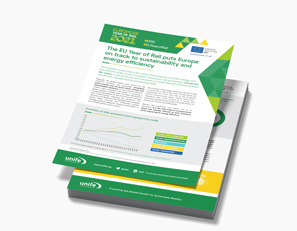Interactive Factsheet
Sustainability and Energy Efficiency
The European Green Deal is the world’s most ambitious climate strategy and the hallmark of the current European Commission, led by President Ursula von der Leyen. It sets all sectors and industries on a path that will transform Europe into the first climate-neutral continent by 2050.
Although the global health crisis caused by the COVID-19 pandemic has demanded immediate policy priority over the Green Deal’s climate and sustainability ambitions, EU and national decision-makers have remained committed to pursuing a green transition. Climate action has been identified as a powerful foundation for the EU’s economic recovery and modernisation following the pandemic. The Recovery and Resilience Plan highlights the European Green Deal’s inclusive and sustainable growth strategy, explicitly calling for “massive investments” in eco-friendly systems across the EU.
The transport and energy sectors are poised to play a crucial role in the Green Deal. The two alone are responsible for more than half of the European Union’s greenhouse gases (GHG) emissions1. Therefore, they must commit to a sound and ambitious decarbonisation plan if Europe wishes to achieve its climate-neutrality goals.
Against this backdrop, rail stands out as an exception. It is the only mode of transportation that has steadily reduced its GHG emissions while improving its energy efficiency.
1 https://www.eea.europa.eu/publications/trends-and-drivers-of-eu-ghg. (Trends and drivers of EU greenhouse gas emissions, 2020)
Evolution of GHG emissions from transport by mode.
EU transport in figures, Statistical pocketbook 2020: Link
Distribution of GHG emissions
between transport modes
Distribution of CO2 emissions between transport modes
EU transport in figures, Statistical pocketbook 2020: Link
To decarbonise transport, a substantial increase of rail’s traffic volumes for passengers and freight is necessary and can be accomplished through incentivising a modal shift, as stated by both the Green Deal and the “Sustainable and Smart Mobility” Strategy.
To remain economically competitive and maintain its strong commitment towards the environment, rail must continue to increase its energy efficiency. Energy, conversely, is one of the main performance drivers of the rail system and is at the heart of the climate-neutral mobility paradigm described in the EU Green Deal.
Investing in energy efficiency and developing projects in synergy with the energy sector will further improve rail transport’s competitiveness as economies transition to a zero-carbon future. Research & Innovation (R&I) is needed to generate solutions needed for a sustainable future.
Through collaborative research programmes, such as Shift2Rail Joint Undertaking and its successor “Europe’s Rail” Joint Undertaking, the whole sector will help foster the eco-friendly revolution created by clean technologies in energy and transport.
“Rail can also contribute to the decarbonisation of the energy sector. As the cleanest mode of mass transportation, it represents the ideal interface for building links between the energy and mobility sectors, developing innovative and sustainable solutions.”

We have already begun to witness the powerful changes that can be brought forward by investments in rail R&I. Shift2Rail projects IN2RAIL and FINE (1&2) are clear examples of how to make the sector greener through research.
The Shift2Rail FINE (1&2) projects are also contributing to the overall reduction of the operational costs of the railway system through the delivery of a standardised methodology for the assessment and measurement of the energy efficiency of new technologies delivered by Shift2Rail.
For example, this has manifested as new carbody shell using lighter materials, independent wheel running gears, use of SiC-semiconductors and the Smart Power Supply. These projects have considerably improved the energy efficiency of the railway system through the development of new knowledge, methodologies, processes, tools and technologies.
Comparison between different sectors with energy and transport as main providers of GHG emissions
European Environmental Agency (EEA): Link (Trends and drivers of EU greenhouse gas emissions, 2020).
